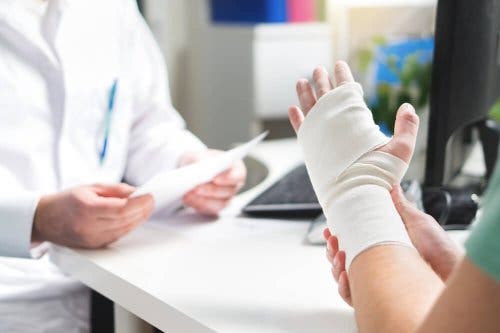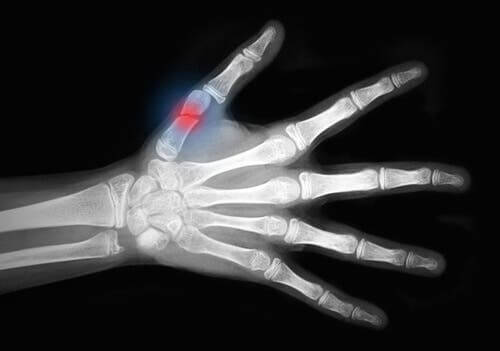Degloving Injuries: What Are They and How Are They Classified?

In the medical field, degloving injuries are traumatic injuries that rip the soft tissues of the skin over large areas and expose the bone. These mainly affect the extremities.
The consequences they cause have no solution, in most cases. When these types of traumatic injuries occur to the head or torso, they’re usually fatal.
Classification of degloving injuries

The classification of soft tissue injuries can help you understand their true extent and implications. Medical professionals use the Tscherne Classification of Soft Tissue Injury, described in a study published in the journal Colombia Médica in 2014, among other publications. In addition, they take tibia fractures and their injuries associated with soft tissue as an example.
According to Tscherne’s classification, soft-tissue injuries are grouped depending on the following grades:
Grade 0
Grade 0 injuries occur in low-energy fractures, such as spinal fractures of the tibia in skiers. There are no obvious clinical signs of injury.
Grade I
The injuries of this group appear when fractures occur with moderate energy. An example of a grade I injury is an ankle dislocation fracture. The released energy produces a mild to moderate soft tissue contusion.
Soft tissue injuries can also occur from the pressure that the fracture fragment exerts on them.
Grade II
Grade II injuries originate from high-energy mechanisms. An example of this type of soft tissue injury is segmental closed tibia fractures due to traffic accidents.
In these cases, the soft parts absorb a lot of energy during the impact and, as a consequence, a deep contusion occurs. This category also includes impending compartment syndromes.
Read on to learn more: 5 Simple and Effective Tips to Overcome a Knee Injury
Grade III
Finally, there are grade III injuries. These injuries are associated with severe skin and muscle damage, such as:
- Vascular injuries.
- Acute compartment syndromes. This is a serious condition that involves increased pressure in a muscle compartment. It can lead to nerve and muscle damage, as well as blood flow problems.
- Crush injuries.
- Degloving injuries.
As you can see, degloving injuries belong to the most serious group of soft tissue injuries.
Advances in the Tscherne Classification of Soft Tissue Injury

Tscherne’s classification was recently expanded. In this expansion, a five-point scale is used that independently quantifies the severity of skin, muscle-tendon, and neurovascular injuries.
This classification is more accurate than the previous one to describe degloving injuries. However, most authors still use Tscherne’s.
Although classifying soft tissue injuries can actually be helpful, their severity increases on a continuous scale. Thus, it’s often difficult to reliably classify a particular injury.
Treatment of degloving injuries
The recognition and management of soft tissues are two of the most important aspects of treatment. Of course, the assistance of a health professional is essential and urgent in these cases.
Grade II and III injuries, according to the classification explained in the previous section, generally heal better with a temporary external fixator and delaying surgery.
In this regard, degloving injuries almost always require major surgical interventions. Additionally, a study published in the Journal of Emergencies, Trauma, and Shock highlights the importance of a multidisciplinary approach. Some treatment options include:
- Reimplantation. Consists of putting together body parts that have been amputated. For example, the fingers of a hand.
- Revascularization. The restoration of blood supply to areas suffering from a high lack of blood supply.
When it isn’t possible, the medical professional makes skin grafts or flaps. However, sometimes, limb preservation isn’t possible. Thus, the medical professional has to perform an amputation.
You should also read: Treatment of Soft Tissue Injuries
Degloving injuries: final recovery
Ultimately, the procedure chosen will depend on the circumstances of each case and the medical team’s assessment.
As the last step, after the surgery, the patient should resort to postoperative physiotherapy sessions. As the cited sources detail, the possible consequences will depend on the severity of the injury and, also, on the type of treatment applied.
All cited sources were thoroughly reviewed by our team to ensure their quality, reliability, currency, and validity. The bibliography of this article was considered reliable and of academic or scientific accuracy.
- Arnez, Z. M., Khan, U., & Tyler, M. P. H. (2010). Classification of soft-tissue degloving in limb trauma. Journal of Plastic, Reconstructive and Aesthetic Surgery. https://doi.org/10.1016/j.bjps.2009.11.029
- Latifi, R., El-Hennawy, H., El-Menyar, A., Peralta, R., Asim, M., Consunji, R., & Al-Thani, H. (2014). The therapeutic challenges of degloving soft-tissue injuries. Journal of emergencies, trauma, and shock, 7(3), 228–232. https://doi.org/10.4103/0974-2700.136870
- Carlos Oliver Valderrama-Molina; Mauricio Estrada-Castrillón; Jorge Andrés Hincapie; Luz Helena Lugo-Agudelo. 2014. Concordancia intra e interobservador de la clasificación de Oestern y Tscherne para lesiones de tejidos blandos en fracturas cerradas periarticulares del miembro inferior. Colombia Médica. http://www.scielo.org.co/pdf/cm/v45n4/es_v45n4a06.pdf
This text is provided for informational purposes only and does not replace consultation with a professional. If in doubt, consult your specialist.








